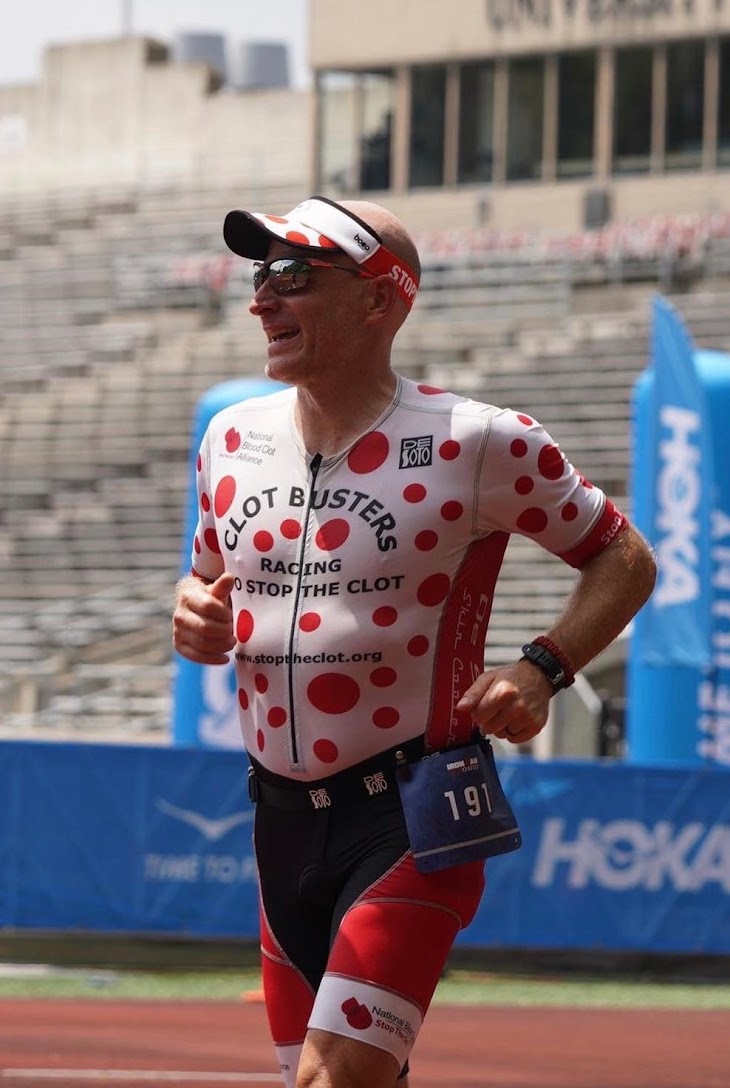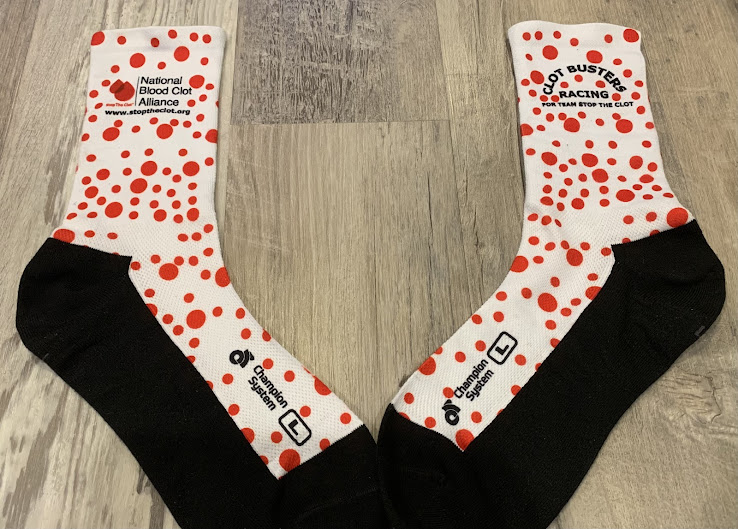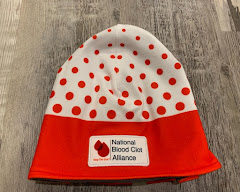Young or old...
Male or Female...
Athletic or Normal...
Soccer Player or Triathlete...
Blood Clots can happen TO ANYONE AT ANYTIME...!!!
You MUST BE AWARE of the signs of symptoms as it can save your life...
Start learning by visiting STOPTHECLOT.org
You will be glad that you did.
You will also be glad to keep on reading... This month's featured blood clot survivor certainly has a story to tell...You don't want want to miss it... so READ ON...
"Eye on the Prize: Maddies Clotting Story
My name is Maddie,
and I am a junior neuroscience major and varsity soccer player on the pre
medical track at Stonehill College, a small DII school in Massachusetts. Soccer
is a huge part of my life, it has always been my escape, my stress reliever and
my happy place. I wouldn’t give it up for anything in the world. Soccer season is
the time of year where I feel completely content with the sport that I love. However, during the 2016-2017 soccer season I found
myself on a journey that changed my life.
The 2016 season was a special one. My team was the underdog
of the Northeast 10 conference, and we had the intent to prove everyone wrong
this season and to shock the nation. We fought our way through many tough games
and constantly pushed ourselves to be the best we could can be; we had each
other’s backs and gave it our all out there. We traveled on busses to different
states to challenge tough opponents; we kept our eye on the prize, to strive to
be champions of our league. I was a sophomore center midfielder at the time, my
job involved a lot of running on both offense and defense in order to have my
teammate’s back all over the field. Well, in October 2016 I learned how well my
teammates had my back too, but this time off the field.
One day when I was walking back from class, I spontaneously developed
this terrible pain in the left side of my head. It was easily the worst
headache I had ever felt. With playoffs in mind I was a bit hesitant to go to
my health center in fear of missing practice, but the pain was enough for me to
get it checked out. I explained to my schools health center that I was a
student athlete and had a history of migraines and this pain was atypical from
any migraine I had ever experienced. They sent me to the local emergency room.
With my knowledge of how serious head injuries can be, I
informed the doctors that I was a student athlete on a contact sport team and
mentioned the possibility of a head injury and inquired about a concussion. I
was surprised when the doctors dismissed my concerns saying I probably did not
need a scan and it was probably just a bad migraine. However, I ended up
returning back to that ER later that night when the pain, dizziness and
vomiting severely worsened. Again I was extremely surprised when the doctors
did not think I needed to be scanned, and was slightly insulted when they joked
and insisted that my pain could have been alcohol induced. I explained that I
was a serious student and dedicated athlete who would not want to miss playoffs
for the world; so my coming into the ER twice meant that my pain was very real.
They did a cognitive concussion test and asked me about my medical history. I
was on oral contraceptives to treat another medical condition, but did not take
any other drugs or drank alcohol. They again sent me back to school and said it
was just a bad migraine.
The next few days were tough. I thought I was foolish and
weak for going to the ER twice with nothing wrong. I tried going back to my
normal life, including going to class and even trying to practice. I struggled.
The dizziness and pain were bad and I felt extremely fatigued from not eating
and drinking much because of nausea. Some of my teammates knew that I was not
okay. These special ladies took extremely good care of me; they helped me
finish my assignments, brought me food, and even held my hand during tough
nights when the pain was particularly bad. A few days after my ER trip, my team
had a game in Syracuse, about a four hour bus ride. I went with them. Although
I wasn’t strong enough to play I wanted to be there to support them. My
teammates continued to support me on this trip as they cared for me when I
wasn’t feeling well at the hotel and comforted me when I had trouble on the
bus. Two of my teammates agreed that the Monday after we got home from our trip
they would drive me to a neurologist. When we got back from our trip that Saturday
night, they put me to bed. However that night I woke in the middle of the night
screaming with pain. I immediately texted my team and one of my teammates
generously came and drove me to the ER. After they finally scanned me, the doctors
were amazed to see the abnormality. They diagnosed me with Cerebral Venous
Sinus Thrombosis, which was a blood clot extending through four major veins in
my brain. They immediately rushed me to the stroke and neurosurgery center of Brigham
and Women’s Hospital where I was monitored. My team of doctors were amazed that
I did not have a major stroke and suffered no neurological injury.
I was so confused on how a young healthy athlete could have
clotting, especially to the severity that I had. The doctors explained that
venous clots are actually more common in athletes than people think. For me the
clots formed by the combination of being dehydrated, constant blows to the head
with a soccer ball, taking oral contraceptives, and being stationary for long
periods of time when traveling on the team bus. They said the terrible headache
I felt that first day could have been when the clot was just forming, and it
grew all that week following when I continued to travel, play, take my
medicine, and remained dehydrated. I was shocked that even the doctors at the
ER never considered a blood clot, and I was thankful that I advocated for
myself and went back that third time even when I was told I was fine.
At Brigham I was treated with blood thinners, to prevent the
existing clot from growing, starting with IV Heparin. Then I was bridged to Lovanox
shots and began taking Coumadin pills. I stayed at the hospital for a few days.
When I was released, the first thing I did was go with my family to my school’s
soccer field where I was able to watch my team win their first playoff game. My
team’s playoff experience was an amazing distraction for all of the crazy
health stuff that was going on in my life. Although I wanted to play, I learned
to accept a new team role as someone on the sidelines who was there to cheer
and motivate my teammates. My team reached our goal and won our conference as
Northeast 10 Champions, advancing to the NCAA tournament. I was lucky to be
healthy enough to go with my team to the NCAAs; even though I had to get my
blood tested when I was traveling to monitor how my blood was clotting.
Being on blood
thinners as a college student was difficult; I went from being a tough and
active athlete, to wearing a medical alert bracelet and being extremely careful
of even the smallest cuts or bruises in fear of internal bleeding. I felt as if
I was a 19 year old trapped in a 95 year old’s body. The months followed
included blood tests every few days, frequent doctor’s appointments and scans,
and a lot of missed school work to make up. I had a lot going on at the time; I
was trying to balance my new medical life with my life as a college student. I
struggled with keeping up with the school while dealing with this head trauma.
I am thankful however for the Academic Services team at my school for helping
me through this time. I am also continually grateful some incredible teammates and
friends who drove me around to these doctor appointments and who were there for
me and supported me emotionally. By February my clots were almost gone and I
was taken off Coumadin and switched to Aspirin as a blood thinner, meaning it
was safe to start to do light play without contact. My eye remained on the
prize; I wanted to do whatever I could to get back on the field. My neurologist
had since also banned me from heavy lifting in fear of putting too much
pressure on my blood. Despite these adjustments I was happy to be on the road
to recovery and expected no more health surprises.
However, in early 2017, I noticed that I was still having
bad throbbing headaches, dizziness and started to notice some hearing
abnormalities. I heard a whooshing sound that I found was rhythmic with my
heartbeat called pulsatile tinnitus. I thought it was nothing, maybe a side
effect from the Aspirin therapy or something. This sound was loud and agonizing;
it was the sound of my pulse in my ear all the time. I always relate the
maddening feeling to the story “Tell Tale Heart.” When the symptoms worsened, I
informed my neurologist and he advised me to get an MRI just to be safe.
A few days later I was taking an exam in my chemistry class
at Stonehill when my phone buzzed on my desk and my neurologist’s number popped
up. Generously, my professor allowed me to take my doctors call. He told me
that my scan was again abnormal, and this time they found something called
Dural Arteriovenous Fistulas. These are very rare lesions around the brain that
are sometimes linked with blood clots. My neurologist explained that there is a
lot about fistulas that are unknown; he said that fistulas are abnormal blood
vessel connections between a vein and an artery. My clot was so large and
clotted so many veins, that my brain tried to compensate for the loss of blood
to those areas by forming channels from my arteries to the veins that needed
blood flow. These can be very dangerous and can cause bleeding or stroke in the
brain.
There are two possibilities for these lesions: that they
could either dissipate or they could grow. Mine unfortunately grew around my
brain, and became larger as more abnormal vessels were constantly being
recruited. In Boston and New York I met with several of the best neurosurgeons
in the country. On May 24,th2017 at NYU Langone Hospital, I had my
first embolization, which is an endovascular neurosurgery to close off the
abnormal vessels around the left side of my brain. Unfortunately, my surgeon
said that my legion grew to be a “monster” and I had to have more treatments
done. I had my second surgery on July 7th 2017 to close off more
vessels on the left side and to stop the ones that were extending to my right
side. There may be more treatments to come, but my neurosurgeon is very
supportive on getting me back to my normal life, which also means being able to
be active and to play soccer.
The thought of playing again and getting back to the sport I
love has definitely given me hope and motivated me. It has truly helped me stay
focused on my recovery. This road to
recovery has been very long and challenging but I am beyond thankful for my
family and friends who have supported me through this entire experience. I am
grateful for Stonehill College’s Athletic Department, Health Services and Academic
Services, which have all helped me adjust to each new obstacle. A big thank you
to those teammates and friends in particular who made this year so much easier
for me; you’ve held my hand through pain and tough news, came to doctors appointments
and emergency room visits, and comforted me after surgery; I don’t know where I
would be without your love and support.
Although it has been beyond challenging to sit out and not
be able to play the sport that I love, I am working hard to reach my goal of
being able to play next season. My team of doctors at NYU are extremely
supportive and understand that part of getting me back to my normal life
includes being an athlete. I am so excited to say that my neurosurgeon has
finally cleared me to play for the fall 2017 season. There is still a lot of
recovering to do, and a lot of training adjustments to be made before next
season. It is going to be challenging, with more obstacles to come, but I am
determined to train hard and put in the work so I can step on that field as
soon as I can.
I am grateful for
Team Stop the Clot and the National Blood Clot Alliance for constantly sharing
survivor stories of athletes and inspiring other athletes like me to work hard
to get back to the sports we love. Blood clots can happen to anyone of any age
and any activity level, it is important to ask your doctor about your own risks
for dangerous clotting, and to be informed on the ways to maintain a healthy
life style. For athletes, things that can make our blood more likely to clot
are dehydration, remaining stationary on long bus rides, and hormonal
medications like oral contraceptives. The most common places for Deep Vein
Thrombosis (blood clots) are in the legs and in the lungs, but can also be
found in the arms or in the brain. Time is a big factor in treating clots as
larger clots can sometimes come with more dangerous and life threatening
complications like mine did. Every clotting experience is different so it is
important to be well informed.
I have faced many obstacles this year, but am extremely
grateful for the blessings as well. Both Dural Fistulas and Blood Clots in the
Brain can be extremely dangerous and they often result in stroke, bleeding, and
neurological damage; I was very lucky not to have experienced these side
effects. There have been a lot of questions by doctors in both Boston and New
York about if I would ever be able to play collegiate soccer again, or any
contact sport for that matter, but like my soccer team last season, I am
determined to prove everyone wrong and to shock the nation. This experience has
taught me a lot, but most importantly it has reminded me of the key lessons
that we are all taught as young athletes; to always listen to your body and to
self-advocate, to appreciate and reciprocate the support of your teammates, to
work hard and stay positive, to always keep your eye on the prize, and to never
ever give up."
You cannot help but to wish Maddie the best of luck in her recovery and return to the sport she loves...She will be back BETTER THAN EVER!
Blood Clot Survivors CAN DO ANYTHING!
Thank you for reading,
The Clot Buster









